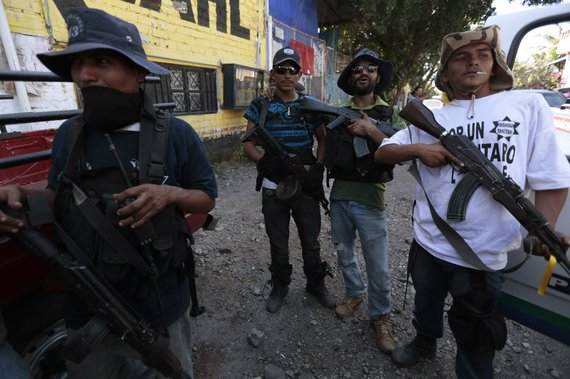To many it might seem as distant memory but 20 years ago in January, a group of indigenous peasants known as the Zapatista Liberation Army (EZLN) led well-versed balaclava-wearing former philosophy teacher, rose up in arms in the southern state of Chiapas. In just a few hours, the rebels managed to capture numerous municipalities, including the city of San Cristobal de las Casas, before the military responded. A dialogue was opened between the rebels and the governments that dragged on for the better part of the next two years and ended in a partial victory for the EZLN: their enclaves would remain autonomous and free from federal government intervention. Yet despite this, Chiapas remains one of Mexico's poorest states, where the country's gut-wrenching inequalities and social deprivations are most evident.
Prosperity Always a Step Too Far
For many, the most shocking aspect of the EZLN's uprising on January 1st 1994 is that it came at a time when most Mexicans were dreaming of modernity: NAFTA had been signed the year before and was set to go into force that very day. But rather than wake up with one foot in the first world, Mexicans entered the new year with the grim reality of underdevelopment flashed on the front page of every world newspaper. This was not a country that was now a free trade partner with two of the richest and most advanced economies in the world: it was still poor, it was still indigenous (a shocking fact to many who believed NAFTA blurred both borders as well as racial lines), and it was still grossly unjust. To make matters worse, the country would be hit one year later by the worst financial crisis in its history, and the "lost decade" of the 1980s would repeat itself.
It is hard to look at the current situation in the country and not feel that there are some worrying similarities with 1994. On one hand, we have a country that is looking increasingly confident in its position in the world after passing a series of landmark structural reforms in 2013. One of these, the liberalization of the energy sector, is possibly the biggest economic game-changer since NAFTA. Just a few weeks earlier, President Enrique Peña Nieto came off as one of Davos's darlings, flaunting the country's progress and his government's success and making it very clear that Mexico is open for business. On the other hand, however, things may not be running so smoothly at home. Lefitsts continue to rile against the "betrayal" of the country's energy sovereignty, while right-wingers deplore the new taxes that the fiscal reform has imposed. Consumers are still weary after a dismal 2013 and are deeply cynical of the positive benefits that the reforms will bring, particularly in the short-run (witness the plummeting of consumer confidence in January). For a country jaded by failed promises, long-term success always feels like a world away.
The New Hot Spot
If a direct parallel is to be made with the Chiapas uprising in 1994, then the current situation in Michoacán is probably as close as it can get. It was in Michoacán where former president Felipe Calderón (a Michoacano himself) first ordered a military intervention back in December 2006, just days after his inauguration, triggering the start of the drug war. But seven years later, hardly anything has changed. Much of the state remained at the mercy of the cartels, which established their own reign of terror of extortion, kidnapping and murder. It did not help that Michoacán had the misfortune of being home to one of the most violent of the lot: the Familia Michoacana (now splintered and rechristened as the Caballeros Templarios or Templar Knights), probably second only to the Zetas in terms of their brutality, and unique among Mexico's cartels in their almost-religious zeal.
The rise of self-defense militas, known locally as the autodefensas, therefore comes as no surprise in a state that has long lost its patience with empty government promises to stem the violence. These autodefensas, initially a ragtag group of farmers fed up with the suffocating grip of the Templarios on practically all economic activity in the state, are now essentially a small army; one powerful enough to have driven the Templarios out of numerous municipalities over the past few months. The government response has been pathetic in its incompetence: first denial, then plans drawn up to disarm them, then most recently a reluctant truce and an agreement to provide them with logistical support in exchange for some degree of regulation (such as a list of members and registry of their weapons). Meanwhile, public support has sided massively in favor of the autodefensas for obvious reasons: they have done more in a few weeks to rid the state of a major cartel than the government has done in as many years and with infinitely more resources.
A Dangerous Precedent
Behind the façade of this recent agreement, however, lies a troublesome fact: the state has effectively given a near-blank check for a paramilitary group to undertake the duties that, in any country where the rule of law is observed, belongs exclusively to the public security apparatus. By doing this, it has essentially recognized that it is utterly incapable of stemming the massive corruption in the ranks of local and state police that prevent them from ensuring peace and safety to its citizens ("narcs with badges" is the common complaint). It has also laid bare the fact that military intervention alone has little lasting benefit. So far, the autodefensas have largely stuck to their professed intent of fighting the Templars and nothing more. But there are dangerous precedents elsewhere in Latin America of what can go wrong when armed militias are given too much freedom to operate.
What is most surprising about the autodefensas is that so far they have only appeared in Michoacán. How could the government respond if such groups suddenly materialize en masse in other drug-ridden states like Sinaloa, Tamaulipas or even the violent outskirts of Mexico City? And if these groups one day decide that the government, rather than the cartels, are the real enemy, could the spectre of 1994 come back to haunt? Here lies the contradiction between modernity and reality in Mexico. It is a country that is keen on gaining the status of an emerging market leader and that is increasingly presenting itself to the world as an example of economic success, business opportunities, and social progress. Yet it is also one that when seemingly on the brink of breaking out in the world stage -- as it is now and as was the case back in 1994 -- always gets a sharp reminder of just how far it still needs to go.

